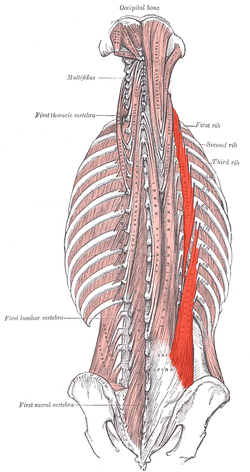Iliocostalis
| Iliocostalis | |
|---|---|
 Deep muscles of the back. (Iliocostalis lumborum visible at bottom right, iliocostalis dorsi visible at center right, and iliocost. cerv. visible at upper right.) | |
| Details | |
| Origin | Sacrum/Illiac Crest/Spinous Processes of lower lumbar/thoracic vertebrae |
| Insertion | Ribs |
| Artery | intercostal and lumbar arteries |
| Nerve | posterior branch of spinal nerve |
| Actions | Unilaterally: laterally flex the vertebral column to the same side. Bilaterally: Extend the vertebral column. |
| Antagonist | Rectus abdominis muscle |
| Identifiers | |
| Latin | musculus iliocostalis |
| TA | A04.3.02.005 |
| FMA | 77177 |
The iliocostalis is the muscle immediately lateral to the longissimus that is the nearest to the furrow that separates the epaxial muscles from the hypaxial. It lies very deep to the fleshy portion of the serratus ventralis (serratus posterior).
Iliocostalis cervicis
The iliocostalis cervicis (cervicalis ascendens) arises from the angles of the third, fourth, fifth, and sixth ribs, and is inserted into the posterior tubercles of the transverse processes of the fourth, fifth, and sixth cervical vertebrae.
Iliocostalis dorsi
The iliocostalis dorsi (musculus accessorius; iliocostalis thoracis) arises by flattened tendons from the upper borders of the angles of the lower six ribs medial to the tendons of insertion of the iliocostalis lumborum; these become muscular, and are inserted into the upper borders of the angles of the upper six ribs and into the back of the transverse process of the seventh cervical vertebra.
Iliocostalis lumborum
The iliocostalis lumborum (iliocostalis muscle; sacrolumbalis muscle) is inserted, by six or seven flattened tendons, into the inferior borders of the angles of the lower six or seven ribs.
See also
References
This article incorporates text in the public domain from the 20th edition of Gray's Anatomy (1918)
External links
- Anatomy figure: 01:06-06 at Human Anatomy Online, SUNY Downstate Medical Center - "Intrinsic muscles of the back."
- Dissection at ithaca.edu